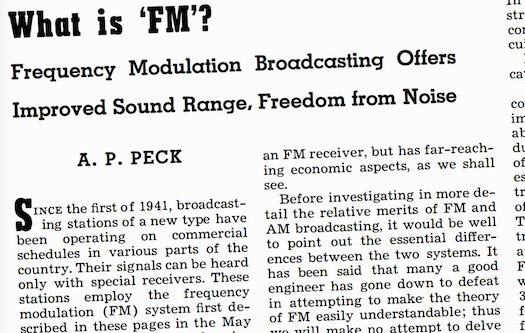Radio Tomorrow with James Cridland
A friend of mine has treated himself to a subscription to Scientific American, and is currently excitedly reading the archives, which come with his purchase.
Back in February 1941, the magazine published a piece about the introduction of FM radio. It attempts to predict the future, but then adds this caution:
“The listening public, not the engineers, will be the deciding factor. FM stations are on the air. They already have large audiences. If these people find in FM something desirable, better, more adapted to their wants, they will demand it. And that demand will be heard and obeyed. In the final analysis it must be remembered that the public made broadcasting possible ; that same group will determine the fate of FM.”
In 2017, we’re seeing a number of countries attempt to promote a successor to analogue FM. It’s interesting to see the differences between them.
The German government is currently looking at a new law that will make it illegal to sell FM radios that don’t, also, have access to both DAB+ and to internet radio. The proposed amendment to the Telecommunications Act is aimed at devices which can “display the program name”, which essentially means high-quality radio receivers like fancy home hifis and car radios. Just 3.4% of radio listening happens over DAB+ in Germany at the moment (and 5.9% for internet radio).
Norway achieved takeup of DAB+ by leaving listeners with no choice: they said they’d turn off FM (and are mid-way through this process). This blow has been softened, somewhat, by significant extra choice: a typical listener would have received less than ten channels on FM, and now gets at least 35 on digital. By the end of last year, before switchoff, 40% of the country’s listening was on DAB+.
Australia appears to have launched DAB+ services in metro areas quite successfully without either legal threats to radio retailers or the threat to listeners of any switchoff. 12% of adults in Sydney listen to digital-exclusive DAB+ stations, and at least 27% of Aussies in DAB+ areas listen digitally in a typical week.
The UK radio industry is internally focused on an arbitrary listening target after which the government might go away and think about switching off FM: but it hasn’t communicated this to the public. Just the experience and the additional stations mean DAB is 32.9% of radio listening (or, at least, was when I wrote this: they release new figures this week).
It’s interesting to consider the words of A. P. Peck, the author of the 1941 Scientific American piece: “If these people find in FM something desirable, better, more adapted to their wants, they will demand it.”
The same goes for DAB, HD Radio, or Internet radio even now. If the product isn’t desirable better, or more adapted to their wants, the industry can probably lobby all their like to promote it, but it’s got a long uphill battle. Better to concentrate on delighting audiences, rather than threatening them, Mr Peck might think.

